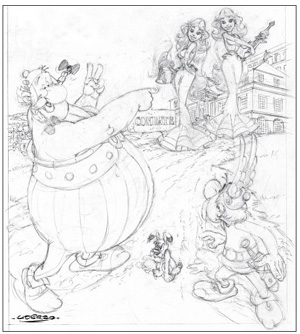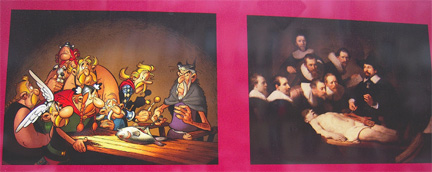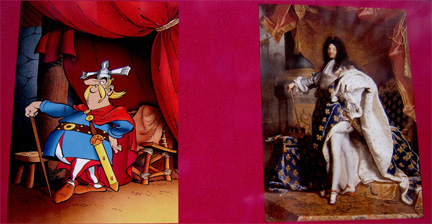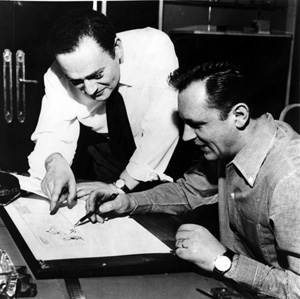Asterix and the Gallo-Roman baths
by Alison Hird
Article published on the 2009-11-08 Latest update 2009-11-08 17:15 TU
Culture: Asterix on exhibition in Roman ruins
Panacea (Asterix’s former flame) poses as the Mona Lisa, the Gauls do a rather different anatomy lesson to that of Rembrandt, while Majestix knocks the spots off Hyacinth Rigaud’s portrait of the Sun King. These are just three of the ten parodies by illustrator Albert Uderzo, displayed on the railings surrounding the Musée de Cluny in Paris’s Latin Quarter.
They set the cheeky tone that’s developed inside the exhibition. Asterix au Musée de Cluny is an uplifting encounter between two national institutions, with the much-loved comic strip character plunging into the gallo-roman baths of the frigidarium at Cluny’s Museum of Medieval History.
And just as Asterix and his corpulent partner Obelix held out so valiantly against the invading Romans, so the frigidarium is one of few survivors of antique Lutetia, as Paris was known in Roman times.
“Of course there are other Roman ruins in Paris but these are exceptionally well-conserved” explains curator Emmanuelle Héran, as we gaze up at the magestic 15-metre-high vault, recently reopened to the public after lengthy restoration work. Héran says the frigidarium (the cold room) is certainly an appropriate if unusual place to host an Asterix exhibition.
“When you mix Asterix and this frigidarium you immediately think about the very famous comic strip – the Bouclier Arverne [Asterix and the Chieftain’s Shield] in which Asterix and Obelix are in the aquae calidae thermal baths in Vichy.”
Drawings of that original mythic scene where Obelix plunges into the village chief’s spa pool, transferring all the water to his own, are displayed in the area where the frigidarium’s pool originally was.
Héran adds that if Asterix and Obelix had existed “they would certainly have come here and taken a bath”.
Asterix was created 50 years ago by illustrator Albert Uderzo and writer René Goscinny and first appeared in the French magazine Pilote in October 1959. To mark the event, Uderzo agreed to loan around 30 original sketches (roughly one from each album) from his huge collection of around 15,000. They all refer in some way or another to antique or Gallo-roman architecture.
Héran says that while neither spoke Latin (they relied on dictionnaries for quotations) and weren’t experts on Roman or Gaulish history, they did plenty of school-book research. The exhibition shows them devouring Julius Caesar's Gallic Wars and you can see notes Goscinny scribbled in biro on pieces of exercise book paper as preparation for Asterix and the Olympic Games. “No pine trees, cypruses” […] “From 776 B.C. the Games are held for 5 days between the end of June and the first days of September”.
They didn’t always get their facts right and used a lot of anachronisms, ruffling the feathers of many a historian. But, as Héran points out, the idea was “not to create a documentary, but to have fun”.
What the exhibition seeks to show above all is the creative process, how those all too familiar pages took shape. “A lot of visitors don’t think about the way it’s created. […] There are only around 30 drawings but it allows you to really see the detail, to see the creative process in action” explains Héran.

Detail from an origan crayon drawing for the cover of Asterix and Latraviata
(Photo: Les Editions Albert René / Goscinny)
The detail comes out all the more since the drawings are in black and white and in larger format than the final colour albums. A preliminary sketch from Asterix and the Actress clearly shows how Uderzo built up his drawing with numerous feathery lines before landing on the right one and inking it over for posterity. Quite the opposite from Hergé’s ligne claire or clean line.
Another plate taken from Asterix and the great crossing (1975) shows how Uderzo used his own inky fingerprints to represent thundery clouds as Asterix and Obelix’s ship is rocked in the storm. Pointing to Cesar’s flowing toga in Asterix in Belgium (1979),
Héran says the self-taught Uderzo had certainly done his homework on Roman attire. “As an art historian I tried to find the model for those roman statues, but couldn’t. It’s a composite. Uderzo knew so much about roman architecture; he could have been a sculptor” she says admiringly.
Uderzo has continued the Asterix albums alone since his partner Goscinny died in 1977 and just released a 34th tome Asterix and Obelix’s birthday: the golden book. It’s a collection of comic vignettes featuring many of the 400 characters that have appeared over the last 50 years. But many agree the best albums were the first 25 they created as a tandem.
And the exhibition aims to show their unique complicity from the first days in 1959 when they started working together in a council flat in the Paris suburbs and published Asterix adventures in French magazine Pilote.
Just next to Goscinny’s Keystone Royal typewriter exhibited in a glass case worthy of Egyptian diamond, you can see his typescript for Asterix the Gaul. “It’s just like a storyboard you’d have in cinema” says Héran. On the right-hand column we see the text “The year is 50 B.C., and Gaul is occupied by the Romans, well not entirely…” while in the left-hand column Goscinny has written instructions for Uderzo: “Roman soldiers marching, we see only their legs like in documentaries showing Germans invading France”.
Back in those early days, Uderzo and Goscinny could never have imagined their plucky hero and his band of indomitable Gauls would go on to sell some 325 million books. More than 200,000 of them have been sold abroad, translated into 107 languages. China and Japan have not drunk the magic potion and the USA remains lukewarm but Asterix has strong fan bases in countries as disparate as Brazil, South Africa, Germany and Indonesia.
There’s no one explanation but Héran says Asterix says more about our society than about warring Romans and Gauls. “It tells about the very nature of French people and humanity in general, the fact you can rebel against powerful people, against authority or stupidity. I think in a way it’s a kind of lesson for people.”
How much longer Asterix will continue la résistance depends largely on who takes over from Uderzo. The 82-year old, sprightly though he is, has controversially sold the rights to Hachette so the series can continue after his death.
Both Uderzo and Goscinny were self-taught. Quite whether the magic touch can be passed on will take an awful lot of potion.
Asterix au Musée du Cluny runs at Musée national du Moyen Age, 6 Place Paul Painlevé, 75005 Paris until 3 January 2010.
Culture
Cracking skulls!
2010-02-15 12:35 TU
France's gothic avant-garde
2010-02-13 15:16 TU
Winter sounds warm up French jazz fans
A tribute to trumpeter Don Cherry at a Free Jazz showcase festival outside of Paris.
2010-01-31 11:55 TU
Trance on a trapeze
2010-01-30 12:41 TU
Retro Mobile - classic car exhibition
260,500 euros for rusty old car found at bottom of lake
A rusty old Bugatti, which spent years at the bottom of a Swiss lake, sold for 260,500 euros at the Retro Mobile classic car exhibition on Saturday. Other more lovingly-restored pristine examples are exciting enthusiasts from across the world in a special anniversary event at Porte de Versailles in Paris.
2010-01-23 20:21 TU
France's changing face looks east
2010-01-22 16:17 TU
Putting art on film
2010-01-20 13:09 TU
What sex is a coffee bean, where does the aubergine come from?
2010-01-08 16:08 TU
Cocteau Twin flying solo
2010-01-06 16:43 TU
A taste of Nordic filmmaking in Paris
Ciné Nordica 2009 at Paris’s Panthéon cinema showcases filmmaking from Scandinavia. So what makes Nordic film different from the rest?
2009-12-22 17:15 TU


















